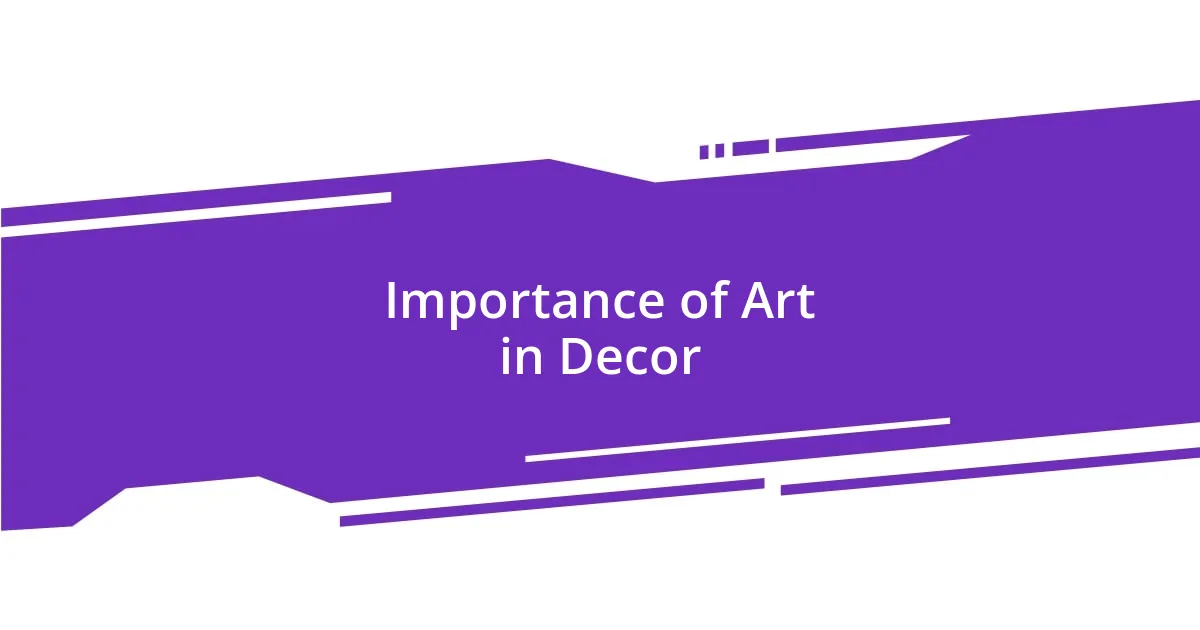Key takeaways:
- Current art trends emphasize sustainability and social justice, with artists utilizing their platforms to address these themes.
- Personalization in home decor is growing, encouraging the use of local artisan work to create unique spaces and foster community connections.
- Choices in art should align with the emotional tone of each room, balancing size, style, and arrangement for optimal impact.
- Sustainable art practices, such as using upcycled materials and supporting local artisans, are increasingly significant in interior decor.

Understanding Art Trends Today
Art trends today often reflect the ebb and flow of cultural values and social movements. I remember walking through a contemporary art exhibit not long ago and feeling a wave of emotion wash over me as I noticed how many pieces tackled themes of sustainability and social justice. It’s fascinating to see how artists use their platforms to respond to our world; have you noticed this shift in recent art?
In my experience, a growing emphasis on personalization in home decor has also shifted how art is approached. I think about my friend who decorates her home with pieces created by local artisans. This trend not only makes her space feel uniquely hers, but it also supports her community. It makes me wonder, wouldn’t it be great if more of us embraced this idea of connection through art?
Additionally, the rise of digital art and NFTs has sparked a new conversation around ownership and value in the art world. I recently attended a workshop on digital creation, and I was struck by how excited people were to explore this medium. It’s incredible to see how technology is reshaping our understanding of art, isn’t it?

Importance of Art in Decor
Art is essential in decor because it breathes life into spaces, reflecting our personalities and values. I fondly recall visiting a friend’s home that was adorned with vibrant paintings; each piece seemed to tell a story, echoing the adventures we shared over the years. The connection I felt to those artworks made the room warm and inviting, proving to me how art can transform a mere house into a home.
Here are some reasons why art is so important in home decor:
– Personal Expression: Art allows individuals to showcase their uniqueness and tastes.
– Emotional Impact: It can evoke feelings and memories, creating a sense of nostalgia or happiness.
– Focal Point Creation: Well-placed art can draw attention to specific areas in a room, guiding the flow of the space.
– Cultural Reflection: It reflects the surrounding culture and can spark conversations about heritage and identity.
– Mood Enhancement: Different styles and colors can influence and enhance the overall vibe of a room.
Ultimately, I believe surrounding ourselves with art that resonates with us creates a richer, more fulfilling living environment.

Popular Art Styles for Homes
When I think about popular art styles for homes, one that often stands out is abstract art. Its free-form shapes and vibrant colors bring a certain dynamism to any space. I once invested in a large piece for my living room, and the moment I hung it up, I noticed how it drew people in—encouraging lively discussions about interpretation and feelings. It’s amazing how a splash of color can change the mood of a room, isn’t it?
Another trend that has caught my eye is the resurgence of vintage art. Pieces that evoke nostalgia can create warmth and familiarity in our modern homes. I remember finding a vintage poster at a flea market, and it immediately sparked cherished memories of my childhood. Incorporating these unique finds not only tells a story but also encourages connections between the past and present.
Furthermore, nature-inspired art is increasingly popular, reflecting our innate connection to the outdoors. I’ve adorned my workspace with prints featuring botanical illustrations, and I’ve found that it brings a sense of calm and serenity, even on chaotic days. This style strikes a harmonious balance between aesthetic appeal and tranquility, making it an excellent choice for any home.
| Art Style | Description |
|---|---|
| Abstract Art | Dynamic forms and colors that evoke emotions and spark conversations. |
| Vintage Art | Nostalgic pieces that connect past memories to modern decor. |
| Nature-Inspired Art | Art that reflects the beauty of the outdoors, often creating a calming atmosphere. |

Choosing Art Based on Space
Choosing art for your space can feel overwhelming, but I’ve learned to let the room guide my decisions. For instance, in my bedroom, I opted for soft, muted landscapes because I wanted a sense of tranquility as I unwind after a long day. How many times have you walked into a room and felt immediately at ease or, conversely, a bit on edge? The right art can truly set the emotional tone of any space, don’t you agree?
In a bustling home office, I found that bright, energizing artwork sparked creativity. I hung a series of colorful geometric prints that not only filled the empty wall but also encouraged me to think outside the box. Art can act as a visual reminder of our ambitions and passions, making it essential to select pieces that align with the energy you wish to cultivate.
The size of the art is also crucial; I once had a huge canvas that dwarfed my tiny dining area. It was striking but ended up feeling more claustrophobic than inspiring. Now, I carefully consider scale, ensuring that each piece harmonizes with its surroundings. Have you ever felt that art was just the right size, complementing everything around it perfectly? That’s the sort of balance I strive for—the kind that enriches the space rather than overwhelms it.

Incorporating Art with Furniture
When I think about incorporating art with furniture, I find that balance is key. I once had this vintage armchair that felt lonely in the corner until I placed a vibrant abstract painting above it. Suddenly, that simple arrangement created a cozy reading nook, one that beckoned me to curl up with my favorite book.
I often experiment with smaller art pieces on shelves or side tables, mixing them with decorative objects. For example, I placed a striking sculpture next to a stack of books on my living room shelf, and it transformed that space into a visually appealing focal point. How do you feel when elements of art interact with everyday items? I can say from experience that it adds a layer of depth and personal expression to any room.
Another approach I love is using furniture to frame the art itself. In my dining room, I opted for a long wooden table that complements a large canvas overhead. The way the table and the artwork converse creates a welcoming atmosphere, making every meal feel like a special occasion. Have you ever noticed how the right arrangement can enhance the beauty of both art and furniture? It’s like creating a living gallery right in your home.

Mixing Art Styles Effectively
When it comes to mixing different art styles, I believe there’s an art to the balance. I once decorated a hallway with a bizarre combination of modern pop art and traditional landscapes—at first, I was nervous if they would clash. However, once hung together, the vibrant colors of the pop art actually brought a playful edge to the serene landscapes, creating a delightful conversation between the pieces. Have you ever felt surprised by how well seemingly opposing styles can coexist?
I’ve also found that incorporating textures can enhance the mixed styles beautifully. In my living room, I paired a sleek, minimalistic sculpture with a textured textile wall hanging. This contrast didn’t only draw the eye but also added depth to the overall aesthetic. Do you ever consider how tactile elements can either clash or complement one another? From my experience, blending different textures can really elevate a space.
It’s important to be intentional about color palettes when mixing styles. There was a time I hung a few eclectic art pieces that had nothing in common visually, and the room felt disjointed. I learned to look for common hues that allowed my diverse pieces to speak to each other. Now, I always choose at least one color that appears consistently across the different art styles to create harmony. How do you approach color when mixing art styles? I think it’s an essential part of curating a cohesive look.

Sustainable Art Trends to Consider
Sustainable art trends are becoming a vital part of home décor as more people recognize the importance of eco-friendly choices. I once discovered an artist who repurposes scrap metal to create stunning sculptures, and it completely shifted my perspective on what art can be. Each piece told a story of transformation, reminding me that beauty can emerge from materials that would otherwise be discarded. Have you ever thought about how sustainable practices in art could change the way we view creativity?
Incorporating local artisans into my decor has also opened my eyes to the unique beauty of sustainable art. I remember attending a local craft fair where I met a talented potter who used clay sourced from nearby rivers. His pieces not only filled my home with character but also supported the local economy and reduced the carbon footprint associated with shipping. Do you feel a deeper connection to art when you know its origins? For me, it’s not just about aesthetics; it’s about fostering community and awareness.
Using upcycled materials in art is another trend I’m excited about. I recently took on a DIY project creating wall art from reclaimed wood, which not only saved money but also enabled me to design a piece that felt entirely mine. The satisfaction of transforming something old into a fresh masterpiece was exhilarating. Have you tried any upcycling projects? If you haven’t, I highly recommend diving in—it’s a fun way to personalize your space while being kind to the planet.












